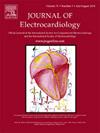使用 ST/HR 滞后可降低无症状中年女性运动心电图测试的假阳性率。
IF 1.3
4区 医学
Q3 CARDIAC & CARDIOVASCULAR SYSTEMS
引用次数: 0
摘要
背景:运动心电图(ECG)是检测冠状动脉疾病(CAD)的常用诊断和预后方法。然而,该方法在无症状女性中的准确性尚未得到全面研究,诊断标准可能需要改进。本研究评估了无症状中年女性心电图ST/HR指数、ST/HR滞后和ST段压低参数的性能。方法:108名女性(平均年龄56±4岁)在9个月内三次在跑步机上进行运动心电图测试,直至力竭。用推荐的诊断分区值评估了运动高峰时和一分钟恢复后从 12 个导联测量的最大 ST/HR 指数、ST/HR 滞后和 ST 段压低值的假阳性率。通过类内相关性(ICC)和Bland-Altman图分析评估了重复性:结果:使用双导联配置而非单导联配置时,所有变量的假阳性率均较低。使用双导联配置时,ST/HR 滞后(0-1.9%)和一分钟恢复后的 ST 段压低(0-2.8%)的假阳性率低于 ST/HR 指数(3.7-20.4%)和运动高峰时的 ST 段压低(9.3-27.8%)。ICC值表明ST/HR滞后的重复性为中等,而ST/HR指数、运动高峰时的ST段和一分钟恢复后的ST段的重复性为中等至良好。Bland-Altman分析表明,所有评估的心电图变量的重复性都较差:结论:对于无症状的中年女性,医生应优先使用 ST/HR 滞后和一分钟恢复后的 ST 段,而不是传统的运动高峰期 ST 段压低或 ST/HR 指数,并从双导联配置而不是单导联评估心电图数据。本文章由计算机程序翻译,如有差异,请以英文原文为准。
Use of ST/HR hysteresis decreases false positive rate in exercise electrocardiography test of middle-aged asymptomatic women
Background
Exercise electrocardiography (ECG) is a common diagnostic and prognostic method for the detection of coronary artery disease (CAD). However, its accuracy in asymptomatic women has not been comprehensively investigated and the diagnostic criteria may require refinements. This study evaluated the performance of ECG-derived ST/HR-index, ST/HR hysteresis and ST-segment depression parameters among asymptomatic middle-aged women.
Methods
108 women (mean age 56 ± 4 years) performed exercise ECG test on treadmill until exhaustion three times within a nine-month period. False-positive rates of maximum ST/HR-index, ST/HR hysteresis, and ST-segment depression values measured from 12 leads at peak exercise and after one-minute recovery were evaluated with recommended diagnostic partition values. Repeatability was assessed with intraclass correlation (ICC) and Bland-Altman plot analysis.
Results
False-positive rate was lower for all variables when a two‑lead configuration was used instead of a single‑lead configuration. Using a two‑lead configuration, ST/HR hysteresis (0–1.9 %) and ST-segment depression after one-minute recovery (0–2.8 %) had lower false-positive rates compared to ST/HR index (3.7–20.4 %) and ST-segment depression at peak exercise (9.3–27.8 %). ICC values indicated moderate repeatability for ST/HR hysteresis while ST/HR index, ST-segment at peak exercise, and ST-segment after one-minute recovery had moderate-to-good repeatability. Bland-Altman analysis indicated poor repeatability for all evaluated ECG variables.
Conclusion
In asymptomatic middle-aged women, practitioners should prefer the use of ST/HR hysteresis and ST-segment after one-minute recovery over the conventional ST-segment depression at peak exercise or ST/HR index, and evaluate the ECG data from a two‑lead configuration instead of single‑lead.
求助全文
通过发布文献求助,成功后即可免费获取论文全文。
去求助
来源期刊

Journal of electrocardiology
医学-心血管系统
CiteScore
2.70
自引率
7.70%
发文量
152
审稿时长
38 days
期刊介绍:
The Journal of Electrocardiology is devoted exclusively to clinical and experimental studies of the electrical activities of the heart. It seeks to contribute significantly to the accuracy of diagnosis and prognosis and the effective treatment, prevention, or delay of heart disease. Editorial contents include electrocardiography, vectorcardiography, arrhythmias, membrane action potential, cardiac pacing, monitoring defibrillation, instrumentation, drug effects, and computer applications.
 求助内容:
求助内容: 应助结果提醒方式:
应助结果提醒方式:


